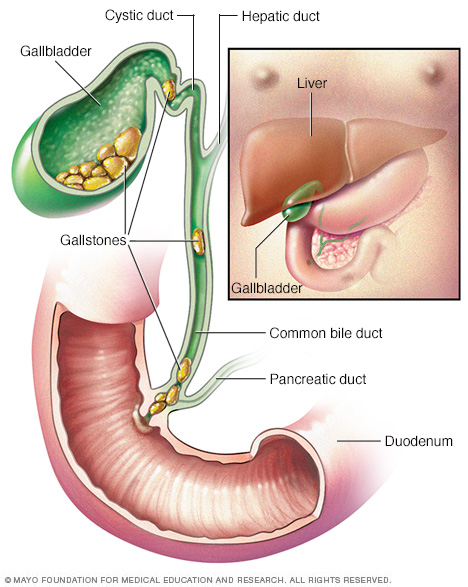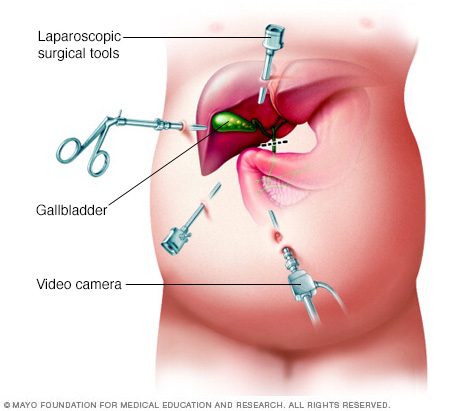Overview
Cholecystitis (ko-luh-sis-TIE-tis) is swelling and irritation, called inflammation, of the gallbladder. The gallbladder is a small, pear-shaped organ on the right side of the belly under the liver. The gallbladder holds fluid that digests food. This fluid is called bile. The gallbladder releases bile into the small intestine.
Most often, gallstones that block the tube leading out of the gallbladder cause cholecystitis. This results in a bile buildup that can cause inflammation. Other causes of cholecystitis include bile duct changes, tumors, serious illness and certain infections.
If not treated, cholecystitis can lead to serious complications, such as gallbladder rupture. These can be life-threatening. Treatment for cholecystitis often involves surgery to remove the gallbladder.

Symptoms
Symptoms of cholecystitis may include:
- Severe pain in the upper right or center belly area.
- Pain that spreads to the right shoulder or back.
- Tenderness over the belly area when it's touched.
- Nausea.
- Vomiting.
- Fever.
Cholecystitis symptoms often come on after a meal. A large or fatty meal is most likely to cause symptoms.
When to see a doctor
Make an appointment with your healthcare professional if you have symptoms that worry you. If your belly pain is so bad that you can't sit still or get comfortable, have someone drive you to the emergency room.
Causes
Cholecystitis is when your gallbladder is inflamed. Gallbladder inflammation can be caused by:
- Gallstones. Most often, cholecystitis is the result of hard particles of bile that can form in the gallbladder, called gallstones. Gallstones can block the tube that carries bile when it leaves the gallbladder. The tube is called the cystic duct. Bile builds up in the gallbladder, causing swelling and irritation.
- Tumor. A tumor may keep bile from draining out of the gallbladder as it should. This causes bile buildup that can lead to cholecystitis.
- Bile duct blockage. Stones or thickened bile and tiny particles called sludge can block the bile duct and lead to cholecystitis. Kinking or scarring of the bile ducts also can cause blockage.
- Infection. AIDS and other infections caused by viruses can cause gallbladder swelling and irritation.
- Serious illness. Very serious illness can damage blood vessels and lessen blood flow to the gallbladder. This can lead to cholecystitis.

Risk factors
Having gallstones is the main risk factor for getting cholecystitis.
Complications
If not treated, cholecystitis can lead to serious complications, including:
- Infection within the gallbladder. If bile builds up in the gallbladder, the bile may get infected.
- Death of gallbladder tissue. Cholecystitis that isn't treated can cause tissue in the gallbladder to die. This is called gangrene. This most common complication mainly affects older people, those who wait to get treatment and those with diabetes. Gangrene can lead to a tear in the gallbladder. Or it may cause the gallbladder to burst.
- Torn gallbladder. A tear, called a perforation, in the gallbladder may result from gallbladder swelling or infection or the death of gallbladder tissue.
Prevention
You can reduce your risk of cholecystitis by taking the following steps to prevent gallstones:
- Lose weight slowly. Fast weight loss can raise the risk of gallstones.
- Be at a healthy weight. Being overweight makes you more likely to get gallstones. To get to a healthy weight, cut calories and increase your physical activity. Stay at a healthy weight through healthy eating and exercise.
- Choose a healthy-eating plan. Eating foods high in fat and low in fiber may raise the risk of gallstones. To lower your risk, eat a lot of fruits, vegetables and whole grains.
Diagnosis
To diagnose cholecystitis, your healthcare professional does a physical exam and asks about your symptoms and medical history. Tests and procedures used to diagnose cholecystitis include:
- Blood tests. Blood tests can look for signs of an infection or other gallbladder issues.
- Imaging tests that show your gallbladder. Abdominal ultrasound, endoscopic ultrasound, CT scan or magnetic resonance cholangiopancreatography can make pictures of your gallbladder and bile ducts. These pictures may show signs of cholecystitis or stones in the bile ducts and gallbladder.
- A scan that shows the movement of bile through the body. A hepatobiliary iminodiacetic acid (HIDA) scan tracks the making and flow of bile from the liver to the small intestine. A HIDA scan involves putting a radioactive dye into your body. The dye attaches to the cells that make bile. During the scan, the dye can be seen as it travels with the bile through the bile ducts. This can show any blockages.
Treatment
Treatment for cholecystitis most often involves a hospital stay to control the swelling and irritation, called inflammation, in your gallbladder. Sometimes, surgery is needed.
At the hospital, treatments to control your symptoms may include:
- Fasting. You may not be able to eat or drink at first to take stress off your inflamed gallbladder.
- Fluids through a vein in your arm. This treatment helps prevent loss of body fluids, called dehydration.
- Antibiotics to fight infection. You might need these if your gallbladder is infected.
- Pain medicines. These can help control pain until the inflammation in your gallbladder is relieved.
- Procedure to remove stones. You may have a procedure called an endoscopic retrograde cholangiopancreatography (ERCP). This procedure uses dye to make the bile ducts show up during imaging. Then a healthcare professional can use instruments to remove stones blocking the bile ducts or cystic duct.
- Gallbladder drainage. Sometimes, gallbladder drainage, called cholecystostomy, can remove infection. You might have this procedure if you can't have surgery to remove your gallbladder. To drain the gallbladder, a healthcare professional can go through the skin on the belly. This method is called percutaneous drainage. Or the health professional could pass a scope through the mouth, called endoscopic drainage.
Your symptoms are likely to get better in 2 to 3 days. But gallbladder inflammation often returns. In time, most people with cholecystitis need surgery to remove the gallbladder.
Gallbladder removal surgery
The procedure to remove the gallbladder is called a cholecystectomy. Most often, this is a minimally invasive procedure called laparoscopic cholecystectomy. This type of surgery uses a few tiny cuts called incisions in your belly. An open procedure, in which a long incision is made in your belly, is rarely needed.
The timing of surgery depends on how bad your symptoms are and your overall risk of complications during and after surgery. If your surgical risk is low, you might have surgery during your hospital stay.
Once your gallbladder is removed, bile flows from your liver into your small intestine, rather than being stored in your gallbladder. You can still digest food without a gallbladder.

Preparing for an appointment
Make an appointment with your healthcare professional if you have symptoms that worry you. For cholecystitis, you may be sent to a specialist in the digestive system, called a gastroenterologist. Or you may be sent to a hospital.
What you can do
Before your appointment:
- Be aware of pre-appointment restrictions. When you make the appointment, ask if there's anything you need to do in advance, such as restrict your diet.
- Make a list of your symptoms, including any that don't seem related to the reason for your appointment.
- Make a list of key personal information, including major stresses or recent life changes.
- Make a list of all medicines, vitamins, herbs and other supplements that you take, including doses.
- Take a family member or friend along, if possible. Someone who goes with you can help you gather information you get.
- Make a list of questions to ask your healthcare professional.
For cholecystitis, some basic questions to ask include:
- Is cholecystitis the likely cause of my belly pain?
- What are other possible causes for my symptoms?
- What tests do I need?
- Do I need to have my gallbladder taken out?
- How soon do I need surgery?
- What are the risks of surgery?
- How long does it take to recover from gallbladder surgery?
- Are there other treatments for cholecystitis?
- Should I see a specialist?
- Are there brochures or other printed material that I can take with me? What websites do you suggest?
Be sure to ask all the questions you have.
What to expect from your doctor
Your healthcare professional is likely to ask you questions, including:
- When did your symptoms begin?
- Have you had pain like this before?
- Are your symptoms constant or do they come and go?
- How bad are your symptoms?
- What, if anything, seems to make your symptoms better?
- What, if anything, seems to make your symptoms worse?
© 1998-2025 Mayo Foundation for Medical Education and Research (MFMER). All rights reserved. Terms of Use


